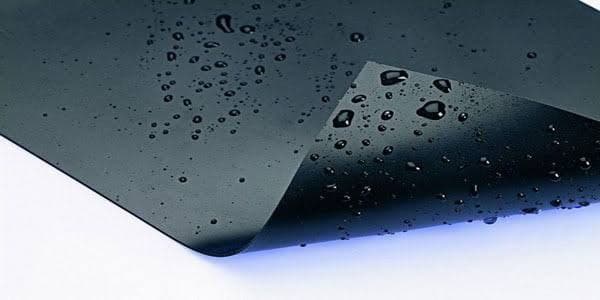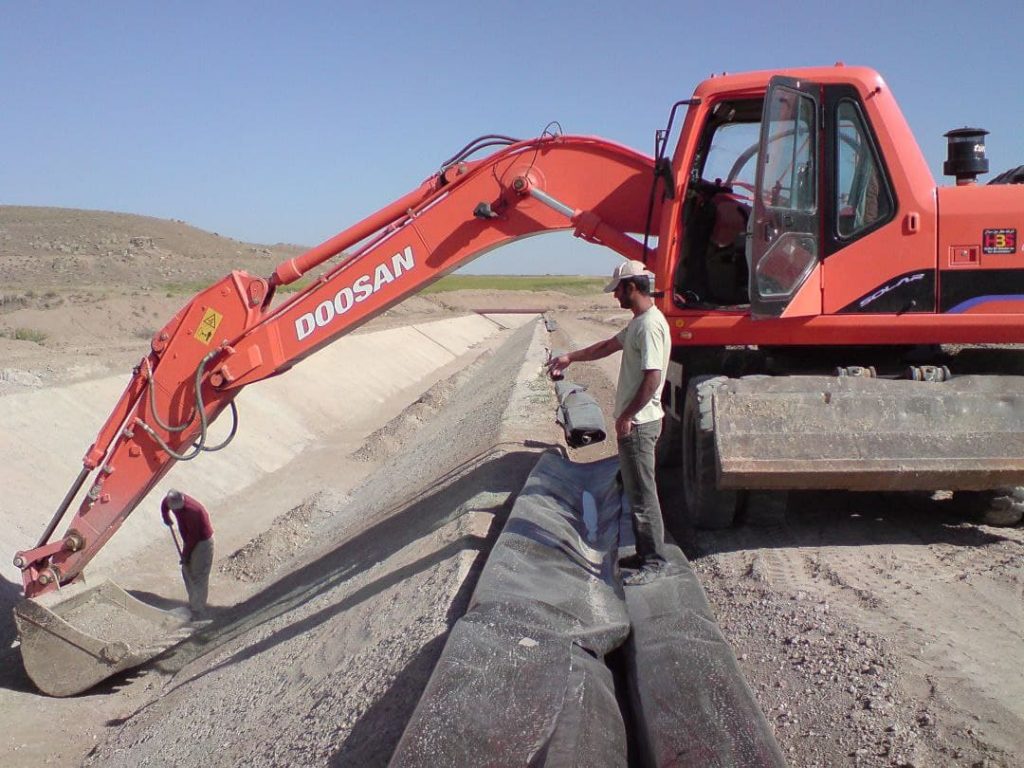Geomembrane vs Geotextile – differences, usages and specs
Geomembranes and geomembrane-related products are considerably impermeable while geotextiles and products related to geotextiles are permeable products. Geocomposites are Products resulting from the industrial combination of two or more geosynthetics.
What is geosynthetic ?
A geosynthetic is a product, of which at least one of the constituents is based on a synthetic (polyethylene, polyamide, polyester or polypropylene) or natural polymer, in the form of a sheet, strip or three-dimensional structure, used in contact with the ground or with other materials in the fields of geotechnics and civil engineering.
The main functions and applications of geosynthetics are:
Separation: to prevent the mixing of two soils or adjacent fill materials of different nature.
– Applications: roads and highways, railways, forest tracks, etc.
Filtration: keeping soil or other particles subjected to hydrodynamic forces while allowing the passage of fluids through or into a geotextile or geotextile-related product.
– Applications: roads, railways, dams, drainage ditches, protection of shores and banks…
Drainage: collection and transport of water, groundwater and/or other fluids in the plane of a geotextile or a product related to geotextiles.
– Applications: drainage under paving, drainage under embankment, driange in ISD*, …
Reinforcement: use of the deformation resistance behavior of a geotextile or a product related to geotextiles, in order to improve the mechanical properties of the soil or other construction materials.
– Applications: backfilling on compressible soils, retaining walls, slope stiffening, etc.
Waterproofing: use of a geosynthetic to prevent or limit the migration of fluids
– Applications: ISD*, Basins, underground structures, …
Protection: prevention or limitation of localized damage to a given element or material by using a geotextile or a product related to geotextiles.
– Applications: protection of geomembranes in various applications.
The fight against surface erosion: use of a geotextile or a product related to geotextiles, in order to avoid or limit the movement of the soil or other particles on the surface.
– Applications: cutting slope; natural slope, …
Anti-cracking: use of a geotextile or a product related to geotextiles to delay surface cracking.
– Applications: roads, airports, etc.
Geosynthetics are defined by physical, mechanical and hydraulic characteristics according to standardized tests, identified for the most part by international standards such as ISO, European type EN, or national standards such as NF, DIN, ASTM, etc.
Buy Geomembrane sheets welding device
Geomembrane specifications, uses and material
Geomembranes are geosynthetics providing a sealing function. They are generally used to remedy water loss by infiltration, or to prevent the migration of pollutants into the ground.
The designation “geomembrane” is subject to the AFNOR NFP 84-5001 standard.
Geomembranes are products suitable for civil engineering, thin, flexible, continuous, impermeable to liquids even under service stresses.
In the current state of the art, neither products with a small functional thickness (less than one millimeter), nor products whose sealing is ensured solely by a clay material, are considered to be geomembranes.
Composition
The basic materials used are of three types:
thermoplastics: high density polyethylene (PE-HD), low density polyethylene (PE-LD), very flexible polyethylene (VFPE), chlorinated polyethylene, polypropylene (PP), flexible polyvinyl chloride (PVC), etc. elastomers: ethylene-propylene-diene terpolymer (EPDM), copolymer of isobutylene and isoprene, chlorosulfonated polyethylene, PP+EPDM mixture bitumens modified with polymers (styrene-butadiene copolymer, ethylene-vinyl acetate copolymer) or not. Conditioning Geomembranes are generally stored in the form of rolls of different lengths and widths, which can vary from 1 m by 10 m for bituminous geomembranes to 7.5 m by 200 m for polyethylene geomembranes, for example.
Fields of employment
They are used in civil engineering, building, agriculture, environment and industries.
The most common uses are:
sealing of water basins;
sealing of hill reservoirs;
sealing of anti-pollution retention basins;
waterproofing of buried walls;
active barrier of waste storage lockers;
containment of liquid waste.
Implementation
When carrying out a structure requiring a geomembrane, the choice of material and the thickness of the latter depends on several criteria such as the nature of the support (concrete, clay soil, etc.), the type of product in contact (water, hydrocarbon, chemical products, etc.) as well as the purpose of the structure (confinement, permanent or temporary retention, etc.).
They are often heat-weldable to make the joints under optimal quality and reliability conditions.
Buy Manual extrusion device for geomembrane installation
Geotextiles specifications, uses and material
Geotextiles belong to the Geosynthetics family, a generic term designating a product of which at least one of the constituents is based on a synthetic or natural polymer. It comes in the form of a sheet, a strip or a three-dimensional structure, used in contact with the ground or with other materials in the fields of geotechnics and civil engineering. Geotextiles have several characteristics that allow them to be used for:
SEPARATION: It avoids the mixing of two soils or filling materials of different nature.
FILTRATION: It maintains the soil and allows the passage of fluids through or in its plane.
DRAINAGE: It collects and transports rainwater, groundwater and/or other fluids in its plane.
PROTECTION: It prevents or limits damage localized by a given element or material.
REINFORCEMENT: It has the ability to resist to improve the mechanical properties of the soil or other building materials.
FIGHT AGAINST SURFACE EROSION: It limits or avoids ground movements mainly on an inclined surface. The mechanical characteristics depend on the base polymer used and the manufacturing method.
The polymers most used to manufacture geotextiles are: PP polypropylenes (the most used currently because they are very chemically stable) PET polyesters Polyamides PA PE polyethylenes For protection, never use a geotextile made of natural material or containing natural fibers because these rot and the protective effect disappears with them. Be very careful with recycled fibers which may partly contain cotton, wool. You must be assured that it is 100% synthetic material (See the polymers mentioned above) Geotextiles are combined into 3 groups, namely non-woven, woven, knitted. Only non-woven geotextiles will be retained for protection because they have interesting puncture resistance values.
Buy Linear low density polyethylene (LLDPE)
There are two methods of manufacturing geotextile:
Heat-bonded non-woven geotextiles (binding fibers together by heat welding) and needle-punched non-woven geotextiles (binding fibers together by intermingling) Thermobonded non-woven geotextiles, recognizable by their rough and slightly cardboardy surface, are not suitable because they cannot be manufactured in sufficient weights to ensure good protection. On the other hand, they are too stiff for proper placement. The puncture resistance values of this product are relatively low. Flexible, thick, heavy needled nonwoven geotextiles have puncture resistance values suitable for protection and should be chosen for this quality.
The PROTECTION function of a geotextile is the first of the characteristics that must be taken into account in the construction of a pool because it is a question of protecting the waterproofing membrane from aggressions from the ground (stones, various elements) and avoiding possible perforation or damage which could itself eventually generate leaks. On the other hand, it should be noted that a soil at the bottom of a basin excavation having a smooth and non-aggressive appearance and surface must nevertheless be protected by a geotextile because, even through a layer of sand, stones or aggressive objects contained in the soil slowly rise to the surface over time and may one day be in contact with the membrane and pierce it by friction a few years after the construction of the pond.
Geomembrane and geotextile:
Geotextiles are permeable technical textiles made of synthetic fibres, used in civil engineering, environmental and landscape architecture works in order to separate, filter, improve drainage, reinforce and more effectively distribute the loads imposed on soils and surfaces. They are permanent and insensitive to the acids found naturally in the soil, which gives them a lifespan exceeding that of the structures they protect.
Geomembranes are used as waterproof water barriers. They are generally made of thermoplastic materials such as polyethylene or polyvinyl chloride but can also be made of bentonite clay, elastomer or other materials. Some specialized geomembranes make it possible, in addition to making structures waterproof, to meet specific needs such as: increased chemical resistance, resistance to low temperatures, compatibility with drinking water, etc.
Buy Geotextile sheets in different grammages
Geosynthetics and sustainability:
According to the definition proposed in 1987 by the World Commission on Environment and Development, sustainable development is:
“Development that meets the needs of present generations without compromising the ability of future generations to meet the needs of their (…) “.
Faced with the urgency of the ecological and social crisis which is now manifesting itself in a globalized way, sustainable development is a response of all actors (states, market, civil society) to reconsider economic growth on a global scale in order to take into account the environmental and social aspects of development. All sectors of activity are concerned.
This applies to the applications of geosynthetic materials. Their use makes it possible to preserve natural resources, for example by reducing the quantities of materials taken from the natural environment (aggregates, sand, clay), by replacing a granular filter with a geotextile of filtration, a granular layer by a drainage geocomposite, or a layer of clay by geomembranes and geosynthetics bentonites. Groundwater and surface water withdrawals are thus reduced, through the use of geosynthetics in basins, canals and altitude restraints. Their use also promotes the protection of water resources by limiting the transfer of pollution through the use of waterproofing and drainage geosynthetics. Lastly, they contribute to reducing dependence on fossil fuels and emissions of greenhouse gas. Indeed, although structures using geosynthetics require the consumption of fossil energy in the same way as other construction materials, including for the manufacture of geosynthetics, the quantity of materials to be transported is significantly reduced compared to a conventional solution: geosynthetics are therefore much more efficient than other engineering materials civilian, if their performance is related to the mass of material used.
Some aspects of the use of geosynthetic materials are both social and environmental. Indeed, geosynthetic materials
participate in the protection of people against natural risks by facilitating prevention or limiting the effects of erosion, collapse, earthquakes, floods and landslides. From a social and societal point of view, geosynthetic materials facilitate the transport of men through their use in transport infrastructures. transportation.
Finally, geosynthetic materials are used to improve the living environment, in particular for the development, preservation and rehabilitation of degraded landscapes and ecosystems, in ornamental basins, as a support for the revegetation of embankments, banks of rivers and coasts.







